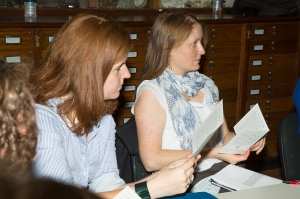RESPONSE #2 Katy Barrett
Encounter, Attention, Negation, Realisation. Copying Sarah’s last post I collected words at this session, given to us as the section titles of a protocol that we went through. I found the session both thought-provoking and irritating, as we were guided through a set of steps for ‘ritual attention’. We focused again on our ten-pound note (along with a number of its fellows) in a series of exercises in close attention and then negation. I felt as we went through the process that we were actually enacting what most museum staff do when encountering any new object: careful looking, handling and analysis.
But this is perhaps where the concept of ritual becomes important. Just 15 minutes before starting the session, I finally managed to see my beautiful Galton weather plates in the ‘flesh’ as they are currently on display in the UCL Octagon Gallery as part of ‘Digital Frontiers.’ Guess what? They are tiny and delicate. In my last response I discussed the difficulty of discussing them without a physical knowledge, and my surprise at their intimate size proves my point. I realised on seeing them that, while attempting to look at the plates in my photographic reproductions, rather than through them, I had still made assumptions about the roughness of their surface and fabrication, when in fact they are very intricate.
The process of standing, trying to look at them in what is essentially a bustling corridor at UCL tied in interestingly with some of the discussions around our attention exercise. Graham, who led the session jointly with Sal, suggested before we started that this would be one of the few spaces were ‘ritualised attention’ still happened, but I thought immediately that this happens all the time in a museum. I stood and focused on my objects in the Octagon Gallery ignoring all the activity around me, and museums and galleries generally encourage a type of focused behaviour. There is, of course, the now hackneyed idea that museums are religious spaces for the modern age. Curators too enact rituals in how they consider and interact with collections. Surely we all interact ritually with objects all of the time? That is what makes them interesting.
Our exercise made me think, though, that museums are also eminently performative spaces. We always act out our attention in relationship to what we see as the perceived custom of a space, based around what we see others doing, and therefore what must be acceptable. I certainly found myself carefully watching Graham and Sal to see what I ‘should’ be doing at each stage. I also felt that, as a group, we ended up performing the process of attention for each other as much as for ourselves. So, in all of these cases, what exactly is it that we are attending to, the objects or the people?

